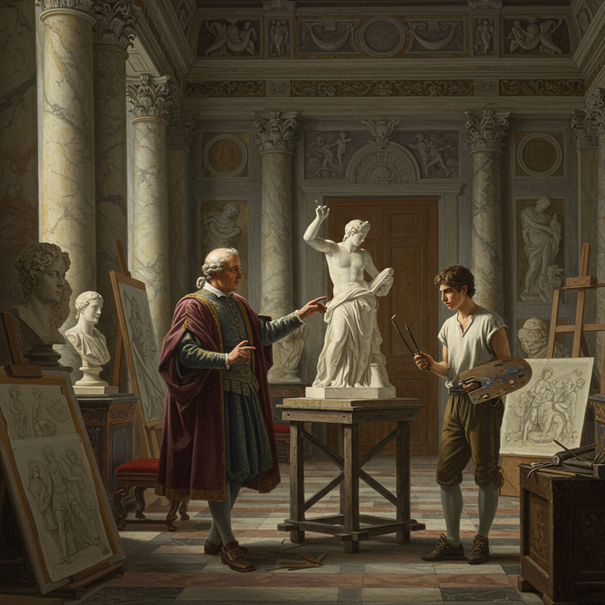Unraveling the Enigma: Bosch's "Garden of Earthly Delights"
- Lavinia de Leonis

- Apr 7
- 3 min read

Ciao, art lovers!
Allow me to share with you a masterpiece that has captivated my soul from the very first glance: Hieronymus Bosch's "The Garden of Earthly Delights." Now, I've been fortunate to witness countless treasures here in the eternal city of Rome, but Bosch? Oh, he transcends the ordinary, inhabiting a realm all his own. Picture, if you will, a fantastical universe brimming with the most peculiar, mind-bending creatures imaginable, all contained within a triptych that feels as if it could lead us to another world entirely.
This is not your conventional Renaissance canvas, let me assure you. We are not gazing upon serene Madonnas or dignified portraits. No, Bosch propels us headlong into a maelstrom of eccentric, almost surreal imagery. It's akin to a vivid dream feverishly brought to life with luminous colors and exquisite precision. And the detail, oh the detail! One could lose oneself for hours—days, even—delving into the myriad of tiny figures and their bizarre, often disquieting pursuits.
The Triptych's Narrative: A Journey Through Creation, Pleasure, and Damnation
Let us delve into this mesmerizing masterpiece together, shall we? This is not merely a solitary painting, but a triumvirate, each panel a tantalizing chapter in an enigmatic and captivating saga. The left panel, depicting the Garden of Eden, appears deceptively serene at first. We witness Adam and Eve, yet even here, there is a whisper of the bizarre to come. The creatures, the landscape, they possess a subtle dissonance. It is as though Bosch is gently foreshadowing the imperfections that will spiral into the pandemonium of the center.
Ah, the central panel—it is here that the narrative erupts into a chaotic dance. A vibrant tapestry of unclothed figures reveling amidst oversized fruits and fantastical beasts. They indulge in a cornucopia of earthly pleasures, some innocent, others decidedly less so. Is this a jubilant ode to earthly delights? Or a cautionary emblem? Despite years of contemplation, I remain delightfully uncertain. And therein lies its irresistible charm. Bosch denies us simple resolutions, compelling us to wrestle with our own desires and interpretations.
Finally, we arrive at the right panel, the terrifying descent into hell. A haunting vision of chaos and retribution, teeming with grotesque beings and nightmarish contraptions. It starkly contrasts the central panel, serving as a chilling reminder of the dire consequences of unchecked indulgence. The sheer creativity of Bosch's hell astounds me, a testament to his boundless imagination and perhaps, his own trepidations.
The Enigma of Interpretation: A Puzzle for the Ages
So, what does it all mean? That, my dear readers, is the million-euro question, is it not? Scholars have been locked in fervent debate over this for centuries. Some perceive it as a moral allegory, a cautionary tale against the indulgences of the flesh. Others suggest it's a surrealist vision, an exploration into the profound depths of the human psyche, long before Surrealism ever graced our artistic lexicon. Personally? I see it as a harmonious blend of both—a complex and ambiguous masterpiece that mirrors the anxieties and fascinations of its era.
Bosch's work possesses a raw, almost visceral quality that continues to resonate with us today. It's unsettling, yes, but also utterly captivating. It beckons us to look beyond the surface, to confront our own desires and fears. It is a painting that lingers in your thoughts long after you have departed the museum. It sows a seed of unease, yet also of wonder.
A Pilgrimage to Madrid: Seeing Bosch's Garden of Earthly Delights in Person
And speaking of museums, if you ever find yourself yearning for a journey into the bizarre and the beautiful, you absolutely must witness "The Garden of Earthly Delights" with your own eyes. It resides within the hallowed halls of the Museo del Prado in Madrid, a pilgrimage no true art aficionado should forgo. Believe me, standing before this monumental creation is an experience you will not soon forget. The sheer scale, the intricate details, the vibrant colors—it is something no photograph could ever truly capture.
So, go! Immerse yourselves in Bosch's fantastical realm. Allow your imagination to run wild. And who knows? Perhaps, just perhaps, you will uncover some of its hidden secrets. Or maybe, like me, you will simply be left in awe, pondering the mysteries of this extraordinary painting.
Until I write for you again, keep your eyes wide open and your hearts brimming with art!

.png)



Comments